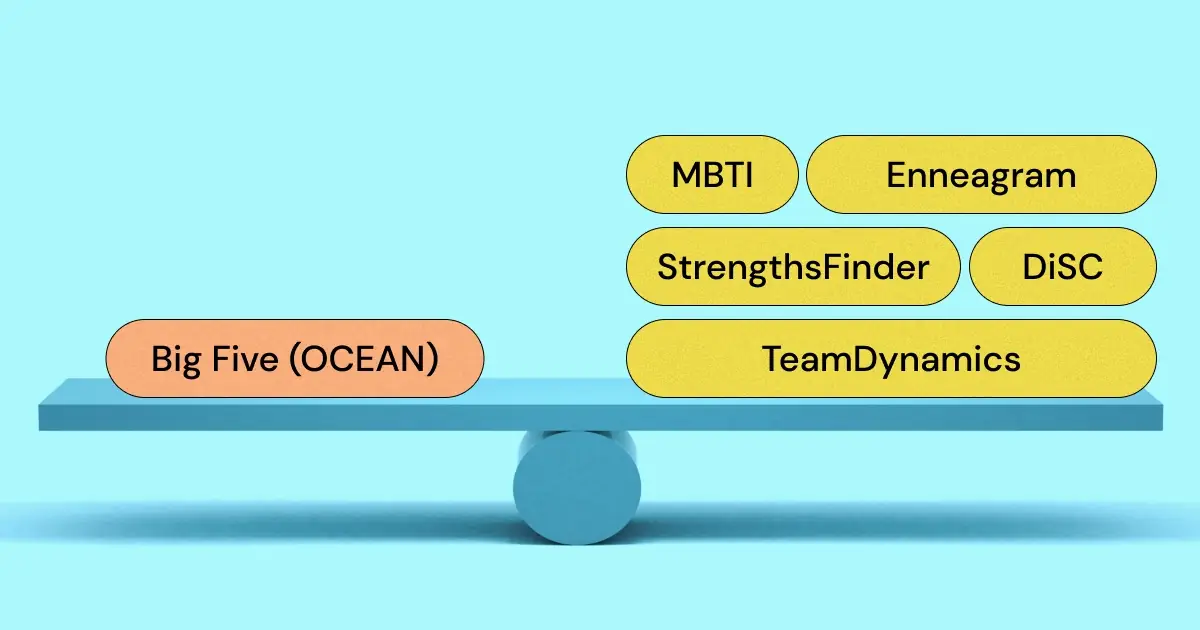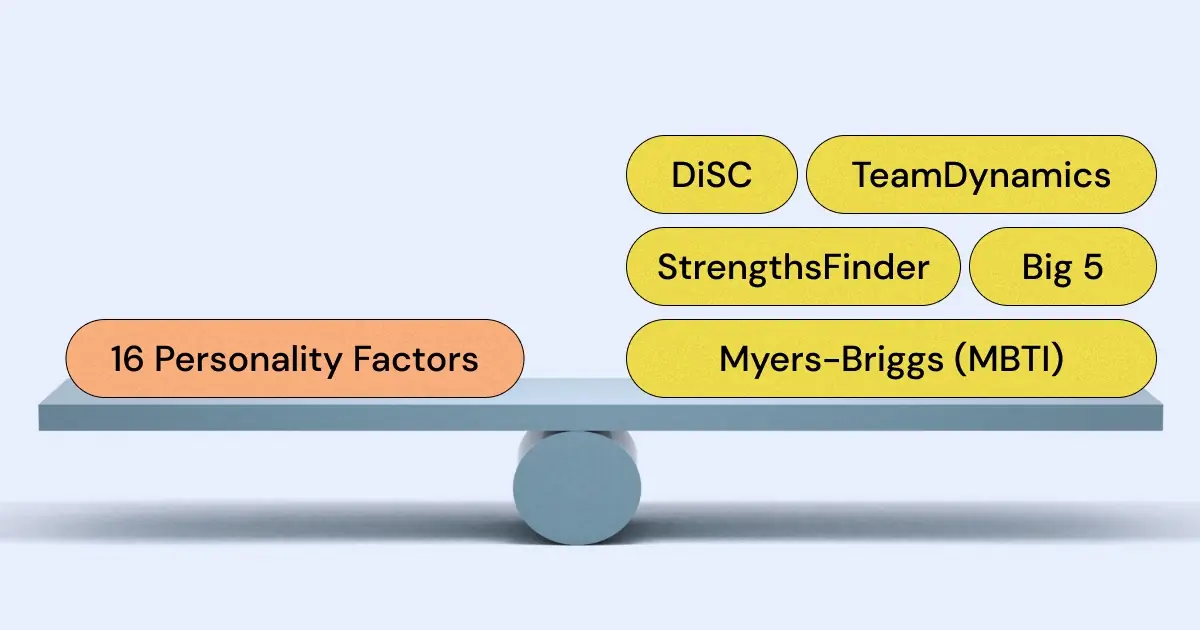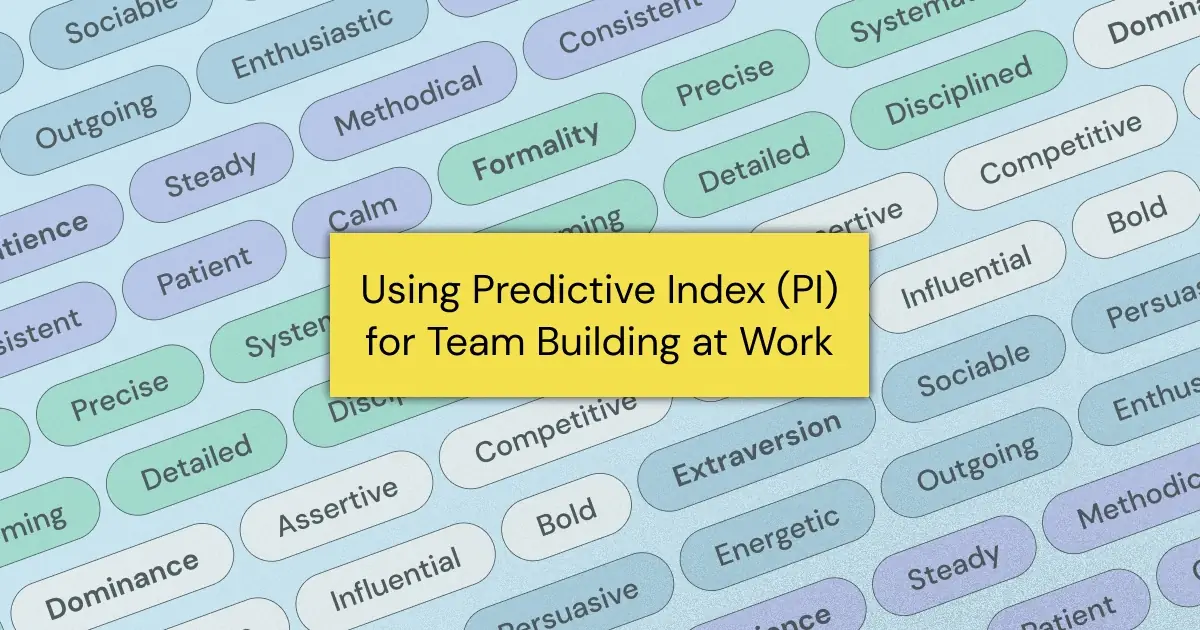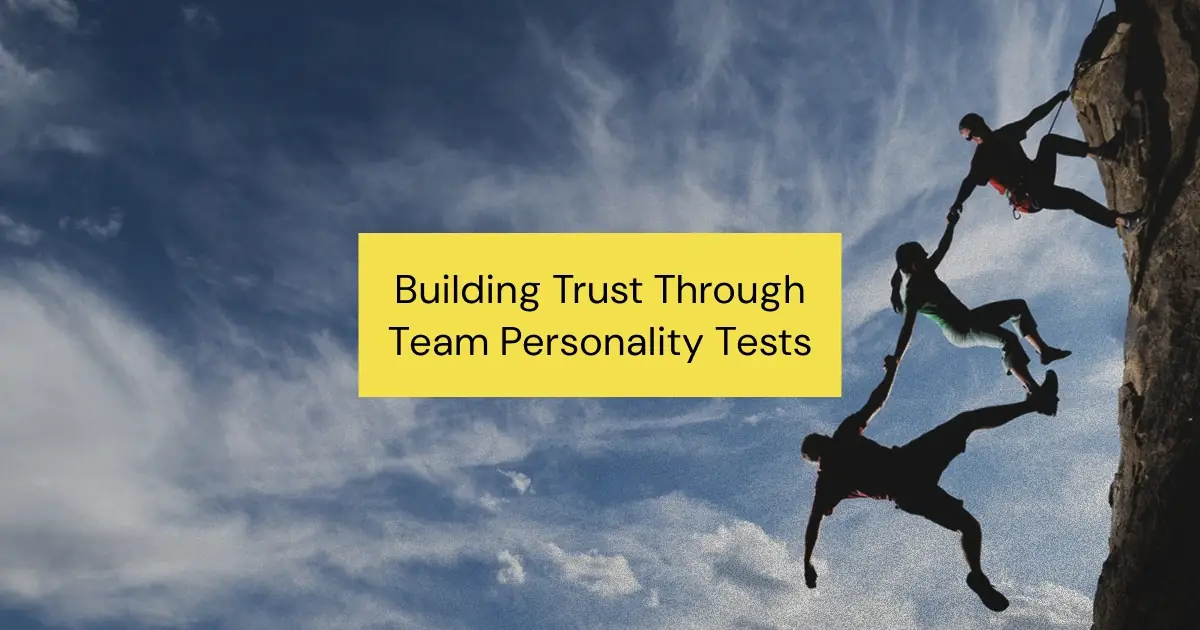Personality tests have become a vital tool in understanding individual differences and improving team dynamics, and there is no shortage of personality test options. Among the most popular is the Big Five Personality Test, which assesses people based on five broad dimensions of personality: Openness, Conscientiousness, Extraversion, Agreeableness, and Neuroticism. While the Big Five (sometimes called the Five Factor Model, or OCEAN) is widely respected for its scientific basis and comprehensive nature, it might not be the perfect fit for everyone or every situation.
Looking to use the Big Five for team building? Check out our free downloadable Big Five team building workshop!
If you’re looking for alternatives to the Big Five that can offer different insights or better suit your needs, you’re in the right place. In this post, we’ll explore five fantastic alternatives to the Big Five Personality Test: Myers-Briggs Type Indicator (MBTI), TeamDynamics, Enneagram, StrengthsFinder (CliftonStrengths), and DiSC. Each of these tests brings its own unique approach to understanding personality and can be incredibly useful in various contexts, especially for team building and personal development.
By the end of this post, you’ll have a clearer understanding of each of these alternatives, their key features, and how they compare to the Big Five. Whether you’re a manager looking to build a more cohesive team or an individual seeking deeper self-awareness, these alternatives offer valuable tools to help you achieve your goals. Let’s find the right personality test for you!
Alternative #1: Myers-Briggs Type Indicator (MBTI)
MBTI provides a more accessible and user-friendly alternative. Its focus on individual preferences and clear, categorical types makes it a valuable tool for personal growth and improving interpersonal relationships.
The Myers-Briggs Type Indicator (MBTI) is one of the most well-known personality tests in the world. Developed by Katharine Cook Briggs and her daughter Isabel Briggs Myers, the MBTI is based on Carl Jung’s theory of psychological types. It classifies individuals into 16 distinct personality types based on their preferences in four dichotomies: Extraversion (E) vs. Introversion (I), Sensing (S) vs. Intuition (N), Thinking (T) vs. Feeling (F), and Judging (J) vs. Perceiving (P)
What Makes MBTI Special
What sets the MBTI apart is its focus on individual preferences and how these influence one’s interaction with the world. Unlike the Big Five, which measures personality traits on a spectrum, the MBTI provides a categorical type that helps people understand their natural tendencies. This approach can make the MBTI feel more personal and relatable, offering insights that are immediately applicable to everyday life. The MBTI’s user-friendly format and emphasis on personal growth and interpersonal understanding make it particularly popular in both personal and professional settings.
Want to use MBTI for team building? Check out our free MBTI team building workshop download!
MBTI vs. Big Five
While both the MBTI and the Big Five are designed to provide insights into personality, they differ significantly in their methodologies and applications. The Big Five measures personality on five broad dimensions, providing a detailed and scientifically robust profile of an individual’s personality traits. In contrast, the MBTI categorizes people into one of 16 personality types, offering a more structured and dichotomous view of personality. This can make the MBTI more intuitive and easier to understand for many people. However, the Big Five is often considered more reliable and valid in scientific research due to its ability to measure personality traits along a continuum.
Practical Applications of MBTI
The MBTI is widely used in various practical applications, particularly in the realms of career counseling, team building, and personal development. Organizations use the MBTI to improve communication and teamwork by helping employees understand their own and their colleagues’ personality types. In career counseling, the MBTI can guide individuals towards careers that align with their natural preferences and strengths. Additionally, the MBTI’s insights can enhance personal relationships by fostering greater empathy and understanding among people with different personality types.
Alternative #2: TeamDynamics
TeamDynamics provides a unique and valuable perspective on team behaviors. By focusing on both individual preferences and collective team norms, TeamDynamics helps teams understand and optimize their interactions, leading to better collaboration and performance. For managers and team leaders aiming to build more cohesive and effective teams, TeamDynamics offers practical, actionable insights that can make a significant difference.
TeamDynamics is a personality test designed specifically for professional environments, with a focus on evaluating team dynamics and individual preferences within a team context. Unlike many traditional personality assessments, TeamDynamics looks at both the collective behaviors of a team and how individual preferences align with or differ from team norms. This dual approach helps teams understand their strengths and areas for improvement, promoting better collaboration and productivity.
What Makes TeamDynamics Special
What makes TeamDynamics stand out is its emphasis on the team as a whole, rather than just individual personalities. By analyzing how team members’ personalities interact, TeamDynamics provides actionable insights into how teams can function more effectively. This approach helps identify potential conflicts, communication barriers, and opportunities for leveraging diverse strengths. The test also highlights how well individuals’ preferences align with the team’s culture, making it easier to spot areas where adjustments might be needed for better synergy.
Curious about what TeamDynamics offers? Download a preview of TeamDynamics today!
TeamDynamics vs. Big Five
While the Big Five Personality Test offers a detailed analysis of individual traits based on five broad dimensions, TeamDynamics focuses on the interplay between team members’ personalities. The Big Five provides a robust, scientifically validated profile of an individual’s traits, which can be useful for personal development and understanding. However, it does not specifically address team dynamics. TeamDynamics, on the other hand, goes beyond individual analysis to explore how these traits affect team interactions and performance. This makes it particularly useful for managers and team leaders looking to optimize team functioning and harmony.
Practical Applications of TeamDynamics
TeamDynamics has numerous practical applications in professional settings. It is particularly valuable for team building, helping managers understand the collective behavior patterns of their teams. By identifying areas where team members’ preferences align or clash, it provides insights into improving communication, reducing conflict, and enhancing overall team performance. Additionally, TeamDynamics can be used in recruitment and onboarding processes to ensure new hires fit well with the existing team culture, leading to smoother integrations and higher productivity.
{{inline-cta}}
Alternative #3: Enneagram
The Enneagram provides a deep, narrative-driven approach to understanding motivations and personal growth. Its focus on core motivations and dynamic nature makes it a valuable tool for personal development and improving interpersonal relationships.
The Enneagram is a personality system that identifies nine distinct personality types, each with its own core motivations, fears, and behaviors. Rooted in ancient spiritual traditions and modern psychology, the Enneagram provides a deep understanding of how individuals view the world and react to different situations. Each type is interconnected, showing how people can exhibit traits from other types under various circumstances.
What Makes Enneagram Special
The Enneagram is unique in its holistic approach, combining psychological insights with spiritual growth. It not only describes personality traits but also delves into the underlying motivations and fears that drive behavior. This deeper understanding can lead to profound personal growth and transformation. Additionally, the Enneagram’s dynamic nature, where individuals can exhibit traits from different types depending on their stress or growth levels, offers a more fluid and comprehensive view of personality.
Enneagram vs. Big Five
While the Big Five Personality Test measures personality based on five broad dimensions, the Enneagram categorizes individuals into nine distinct types with specific motivations and fears. The Big Five provides a trait-based, scientifically validated profile that is useful for understanding behavior patterns and tendencies. In contrast, the Enneagram offers a more narrative and transformational approach, focusing on personal development and self-awareness. While the Big Five excels in its empirical rigor, the Enneagram’s strength lies in its depth of insight into human nature and personal growth.
Want to use the Enneagram for team building? Check out our free Enneagram team building download!
Practical Applications of Enneagram
The Enneagram is widely used in personal development, relationship counseling, and team building. By understanding their Enneagram type, individuals can gain insights into their core motivations and areas for growth. In a team setting, the Enneagram helps members understand each other’s perspectives and work more harmoniously. It is also valuable in leadership development, as it provides leaders with tools to understand and motivate their team members effectively. Additionally, the Enneagram can enhance interpersonal relationships by fostering empathy and communication.
Alternative #4: StrengthsFinder (aka Gallup CliftonStrengths)
StrengthsFinder provides a focused and practical approach to personal and professional development. By identifying and leveraging strengths, StrengthsFinder helps individuals and teams achieve their full potential.
StrengthsFinder, now branded as CliftonStrengths, was developed by Donald Clifton and is based on the idea that understanding and leveraging one’s strengths leads to greater personal and professional success. The assessment identifies an individual’s top strengths from a list of 34 themes, focusing on what they naturally do best. This strengths-based approach helps individuals and teams maximize their potential by building on their innate talents.
What Makes StrengthsFinder Special
StrengthsFinder is unique in its focus on strengths rather than weaknesses. Instead of highlighting areas for improvement, it encourages individuals to cultivate their natural talents. This positive approach can boost confidence and motivation, making it a powerful tool for personal development and team building. By helping people understand their top strengths, StrengthsFinder enables them to contribute more effectively in their roles and collaborate better with others who have complementary strengths.
StrengthsFinder vs. Big Five
While the Big Five Personality Test measures broad personality traits on a spectrum, StrengthsFinder zeroes in on specific strengths that individuals can harness. The Big Five provides a detailed and scientifically robust profile of personality traits, useful for understanding behavior patterns and tendencies. In contrast, StrengthsFinder offers a more practical approach by identifying concrete strengths that individuals can actively develop and apply. This makes StrengthsFinder particularly useful for career development and team performance, as it focuses on actionable insights rather than abstract traits.
Want to use StrengthsFinder for team building? Check out our free CliftonStrengths team building workshop download!
Practical Applications of StrengthsFinder
StrengthsFinder has wide-ranging applications in both personal and professional contexts. In the workplace, it is used for team building, leadership development, and career coaching. Managers can use StrengthsFinder to understand their team’s strengths and strategically assign roles that align with each member’s talents. This can lead to increased productivity, job satisfaction, and overall team effectiveness. On a personal level, individuals can use their strengths profile to make informed career choices and pursue opportunities that align with their natural abilities.
Alternative #5: DiSC Assessment
DiSC provides a simple, practical approach to understanding and applying personality insights in the workplace. Its focus on observable behaviors and straightforward categorization makes it an excellent tool for improving communication, teamwork, and leadership.
The DiSC personality assessment categorizes individuals into four main personality traits: Dominance (D), Influence (I), Steadiness (S), and Conscientiousness (C). Developed by psychologist William Moulton Marston, DiSC focuses on understanding behavioral differences and how they affect workplace interactions. Each trait represents a particular style of behavior, communication, and work preference, providing a straightforward framework for understanding oneself and others.
What Makes DiSC Special
DiSC is known for its simplicity and practical application in the workplace. Unlike many personality tests that delve deeply into psychological theory, DiSC offers clear, actionable insights that can be easily understood and implemented. Its straightforward classification into four traits makes it easy for individuals and teams to remember and apply. This makes DiSC particularly useful for improving communication, resolving conflicts, and enhancing teamwork. The test’s focus on observable behavior rather than internal traits also makes it more accessible for practical use.
DiSC vs. Big Five
While the Big Five Personality Test provides a detailed and scientifically validated analysis of five broad personality traits, DiSC simplifies personality into four behavioral styles. The Big Five measures personality on a continuum, offering a nuanced understanding of individual differences. In contrast, DiSC categorizes behaviors into distinct types, making it easier to understand and apply in real-world scenarios. The Big Five excels in its depth and precision, while DiSC’s strength lies in its simplicity and immediate applicability, especially in professional settings.
Want to use DiSC for team building? Check out our free DiSC team communication workshop download!
Practical Applications of DiSC
DiSC is widely used in business environments for team building, leadership development, and improving workplace communication. Managers use DiSC to understand their team’s behavioral styles and adapt their management approach accordingly. It helps in identifying potential sources of conflict and finding ways to resolve them effectively. DiSC can also guide career development by helping individuals choose roles that match their behavioral style. In training and development programs, DiSC provides a common language for discussing personality and behavior, making it easier to address team dynamics and performance issues.
Comparing the 5 Best Alternatives to Big Five
So which of these leading alternatives to the Big Five personality test is right for you and your workplace? Take a look at this simple comparison table to find out!
| Tool |
Primary Focus |
Pricing |
Best For |
Key Strengths |
| Myers-Briggs Type Indicator (MBTI) |
Personality Preferences |
One-time Payment |
Personal growth and career alignment |
16 personality types, intuitive, widely recognized |
| TeamDynamics |
Team Synergy and Dynamics |
One-time Payment |
Teams aiming for collaboration and productivity |
Assesses entire team, aligns individual and team norms |
| Enneagram |
Core Motivations and Fears |
Typically Free/One-time Payment |
Personal growth and emotional intelligence |
Nine types, focuses on motivations and growth |
| StrengthsFinder (Gallup CliftonStrengths) |
Individual Strengths |
One-time Payment |
Personal and career development |
34 talent themes, strength-focused development |
| DiSC Assessment |
Behavior and Communication Styles |
Subscription/One-time Payment |
Improving workplace communication |
Simple, practical, enhances workplace interactions |
Conclusion
In this blog post, we’ve explored five notable alternatives to the Big Five Personality Test: Myers-Briggs Type Indicator (MBTI), TeamDynamics, Enneagram, StrengthsFinder (CliftonStrengths), and DiSC. Each of these tests offers unique insights and benefits:
- MBTI helps individuals understand their personality preferences through a straightforward categorization into 16 types, fostering personal growth and better interpersonal relationships.
- Enneagram provides a deep, narrative-driven understanding of motivations and fears, promoting profound personal development and empathy in team settings.
- StrengthsFinder focuses on identifying and leveraging individual strengths, making it highly practical for career development and team performance.
- DiSC offers a simple, behavior-based framework, making it particularly useful for improving workplace communication and resolving conflicts.
However, TeamDynamics stands out as a particularly valuable tool for professional environments. Its unique dual approach of evaluating both individual preferences and collective team behaviors provides comprehensive insights that can transform team dynamics. By highlighting how well individuals’ preferences align with team norms, TeamDynamics helps managers identify potential areas of conflict and opportunities for better collaboration.
For managers and team leaders aiming to build cohesive, effective teams, TeamDynamics offers practical, actionable insights that can significantly enhance team performance. Its focus on team dynamics, combined with its ability to provide personalized feedback, makes it the right choice in most professional contexts. Whether you’re looking to improve communication, foster better collaboration, or optimize team productivity, TeamDynamics provides the tools you need to achieve your goals. Try TeamDynamics today and see how it can unlock your team’s full potential.


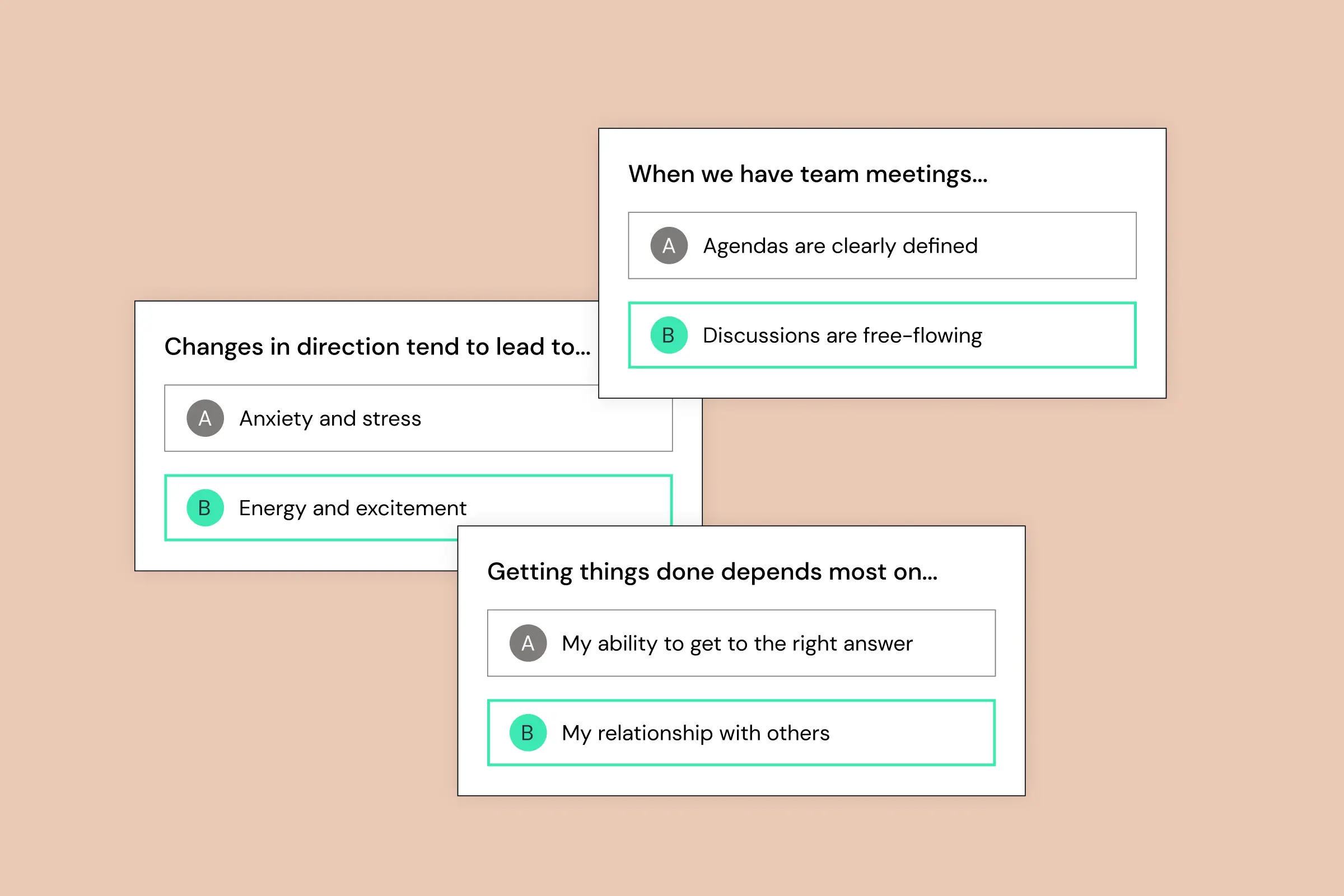

.png)
